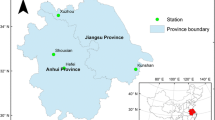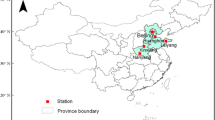Abstract
The long-term field experiment data at four representative agro-meteorological stations, together with a crop simulation model, were used to disentangle the contributions of climate change, variety renewal, and fertilization management to rice yield change in the past three decades. We found that during 1981–2009 varieties renewal increased rice yield by 16%–52%, management improvement increased yield by 0–16%, and the contributions of climate change to rice yield varied from — 16% to 10%. Varieties renewal and management improvement offset the negative impacts of climate change on rice production. Among the major climate variables, decreases in solar radiation reduced rice yield on average by 0.1%per year. The impact of temperature change had an explicit spatial pattern. It increased yield by 0.04%–0.4% per year for single rice at Xinbin and Ganyu station and for late rice at Tongcheng station, by contrast reduced yield by 0.2%–0.4% per year for single rice at Mianyang station and early rice at Tongcheng station. During 1981–2009, rice varieties renewal was characterized by increases in thermal requirements, grain number per spike and harvest index. The new varieties were less sensitive to climate change than old ones. The development of high thermal requirements, high yield potential and heat tolerant rice varieties, together with improvement of agronomic management, should be encouraged to meet the challenges of climate change and increasing food demand in future.
Similar content being viewed by others
References
Angstrom A (1924). Solar and terrestrial radiation. Report to the international commission for solar research on actinometric investigations of solar and atmospheric radiation. Q J R Meteorol Soc, 50(210): 121–126
Bachelet D, Gay C A (1993). The impacts of climate change on rice yield: a comparison of four model performances. Ecol Modell, 65(1–2): 71–93
Bryan B A, King D, Zhao G (2014). Influence of management and environment on Australian wheat: information for sustainable intensification and closing yield gaps. Environ Res Lett, 9(4): 044005
Chen B, Chen G (2007). Resource analysis of the Chinese society 1980–2002 based on exergy—Part 3: agricultural products. Energy Policy, 35(4): 2065–2078
Cheyglinted S, Ranamukhaarachchi S, Singh G (2001). Assessment of the CERES-Rice model for rice production in the Central Plain of Thailand. J Agric Sci, 137(03): 289–298
Deng X, Huang J, Qiao F, Naylor R L, FalconWP, Burke M, Rozelle S, Battisti D (2010). Impacts of El Nino-Southern Oscillation events on China’s rice production. J Geogr Sci, 20(1): 3–16
Kucharik C J, Serbin S P (2008). Impacts of recent climate change on Wisconsin corn and soybean yield trends. Environ Res Lett, 3(3): 034003
Lin E, Xiong W, Ju H, Xu Y, Li Y, Bai L, Xie L (2005). Climate change impacts on crop yield and quality with CO2 fertilization in China. Philos Trans R Soc Lond B Biol Sci, 360(1463): 2149–2154
Liu L, Wang E, Zhu Y, Tang L, Cao W (2013). Quantifying three-decade changes of single rice cultivars in China using crop modeling. Field Crops Res, 149(0): 84–94
Liu Y, Tao F (2012). Impacts and uncertainty analysis of elevated temperature and CO2 concentration on wheat biomass. J Geogr Sci, 22(6): 1002–1012
Lobell D B, Asner G P (2003). Climate and management contributions to recent trends in U.S. agricultural yields. Science, 299(5609): 1032
Lobell D B, Field C B (2007). Global scale climate–crop yield relationships and the impacts of recent warming. Environ Res Lett, 2 (1): 014002
Nendel C, Kersebaum K C, Mirschel W, Wenkel K O (2014). Testing farm management options as climate change adaptation strategies using the MONICA model. Eur J Agron, 52(0): 47–56
Peng S, Cassman K G, Virmani S S, Sheehy J, Khush G S (1999). Yield potential trends of tropical rice since the release of IR8 and the challenge of increasing rice yield potential. Crop Sci, 39(6): 1552–1559
Peng S, Huang J, Sheehy J E, Laza R C, Visperas R M, Zhong X, Centeno G S, Khush G S, Cassman K G (2004). Rice yields decline with higher night temperature from global warming. Proc Natl Acad Sci USA, 101(27): 9971–9975
Peng S, Tang Q, Zou Y (2009). Current status and challenges of rice production in China. Plant Prod Sci, 12(1): 3–8
Pinnschmidt H, Batchelor W, Teng P (1995). Simulation of multiple species pest damage in rice using CERES-rice. Agric Syst, 48(2): 193–222
Prescott J A (1940). Evaporation from a water surface in relation to solar radiation. Trans R Soc S Aust, 64: 114–118
Shi W, Tao F (2014a). Spatio-temporal distributions of climate disasters and the response of wheat yields in China from 1983 to 2008. Nat Hazards, 74(2): 569–583
Shi W, Tao F (2014b). Vulnerability of African maize yield to climate change and variability during 1961–2010. Food Security, 6(4): 471–481
Shi W, Tao F, Zhang Z (2013). A review on statistical models for identifying climate contributions to crop yields. J Geogr Sci, 23(3): 567–576
Tao F, Hayashi Y, Zhang Z, Sakamoto T, Yokozawa M (2008). Global warming, rice production, and water use in China: developing a probabilistic assessment. Agric Meteorol, 148(1): 94–110
Tao F, Yokozawa M, Xu Y, Hayashi Y, Zhang Z (2006). Climate changes and trends in phenology and yields of field crops in China, 1981–2000. Agric Meteorol, 138(1–4): 82–92
Tao F, Zhang S, Zhang Z (2012). Spatiotemporal changes of wheat phenology in China under the effects of temperature, day length and cultivar thermal characteristics. Eur J Agron, 43(0): 201–212
Tao F, Zhang Z, Shi W, Liu Y, Xiao D, Zhang S, Zhu Z, Wang M, Liu F (2013). Single rice growth period was prolonged by cultivars shifts, but yield was damaged by climate change during 1981–2009 in China, and late rice was just opposite. Glob Change Biol, 19(10): 3200–3209
Tao F, Zhang Z, Xiao D, Zhang S, Rötter R P, Shi W, Liu Y, Wang M, Liu F, Zhang H (2014). Responses of wheat growth and yield to climate change in different climate zones of China, 1981–2009. Agric Meteorol, 189–190(0): 91–104
Timsina J, Humphreys E (2006). Performance of CERES-Rice and CERES-Wheat models in rice–wheat systems: a review. Agric Syst, 90(1–3): 5–31
Xiao D, Moiwo J, Tao F, Yang Y, Shen Y, Xu Q, Liu J, Zhang H, Liu F (2013a). Spatiotemporal variability of winter wheat phenology in response to weather and climate variability in China. Mitig Adapt Strategies Glob Change
Xiao D, Tao F (2014). Contributions of cultivars, management and climate change to winter wheat yield in the North China Plain in the past three decades. Eur J Agron, 52(0): 112–122
Xiao D, Tao F, Liu Y, Shi W, Wang M, Liu F, Zhang S, Zhu Z (2013b). Observed changes in winter wheat phenology in the North China Plain for 1981–2009. Int J Biometeorol, 57(2): 275–285
Xiong W, Holman I, Lin E, Conway D, Li Y, Wu W (2012). Untangling relative contributions of recent climate and CO2 trends to national cereal production in China. Environ Res Lett, 7(4): 044014
Yu Y, Huang Y, Zhang W (2012). Changes in rice yields in China since 1980 associated with cultivar improvement, climate and crop management. Field Crops Res, 136(0): 65–75
Zhang S, Tao F (2013). Modeling the response of rice phenology to climate change and variability in different climatic zones: comparisons of five models. Eur J Agron, 45(0): 165–176
Zhang Z, Wang P, Chen Y, Zhang S, Tao F L, Liu X F (2014). Spatial pattern and decadal change of agro-meteorological disasters in the main wheat production area of China during 1991–2009. J Geogr Sci, 24(3): 387–396
Author information
Authors and Affiliations
Corresponding author
Rights and permissions
About this article
Cite this article
Zhang, H., Tao, F., Xiao, D. et al. Contributions of climate, varieties, and agronomic management to rice yield change in the past three decades in China. Front. Earth Sci. 10, 315–327 (2016). https://doi.org/10.1007/s11707-015-0527-2
Received:
Accepted:
Published:
Issue Date:
DOI: https://doi.org/10.1007/s11707-015-0527-2




